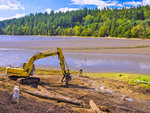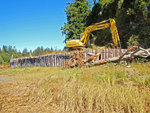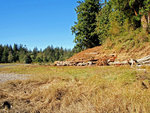To restore the property, Reeves removed a 150-foot bulkhead made of pilings set in the bay and more than 700 cubic yards (70 truck loads) of backfill
A portion of Tarboo Bay’s shoreline was …
This item is available in full to subscribers.
We have recently launched a new and improved website. To continue reading, you will need to either log into your subscriber account, or purchase a new subscription.
If you had an active account on our previous website, then you have an account here. Simply reset your password to regain access to your account.
If you did not have an account on our previous website, but are a current print subscriber, click here to set up your website account.
Otherwise, click here to view your options for subscribing.
* Having trouble? Call our circulation department at 360-385-2900, or email our support.
Please log in to continue |
|



To restore the property, Reeves removed a 150-foot bulkhead made of pilings set in the bay and more than 700 cubic yards (70 truck loads) of backfill
A portion of Tarboo Bay’s shoreline was renewed last week by removing a residential development that had built on top of a saltmarsh in the 1970s. Northwest Watershed Institute (NWI) and contractor Doug Reeves, owner of Reeves Excavating and Land Clearing, completed the restoration work by removing a bulkhead, fill dirt, house and septic system from a portion of the shoreline property and preparing it for planting with native vegetation this winter.
The property was purchased in May of 2014 by NWI, a nonprofit conservation organization, for long-term preservation and restoration. The narrow property is only 1.5 acres but stretches nearly a quarter mile along Tarboo Bay's northeast edge, with most of the saltmarsh and forested shoreline still intact.
The land acquisition was made possible by grant funding from the Washington Department of Fish and Wildlife’s Estuary and Salmon Restoration Program and the U.S. Fish and Wildlife Service’s National Coastal Wetlands Conservation Program administered by Washington Department of Ecology.
To restore the property, Reeves removed a 150-foot bulkhead made of pilings set in the bay and more than 700 cubic yards (70 truck loads) of backfill, based on a design prepared by Chinook Engineering. Reeves also removed a house and septic system perched along the shoreline. Using the excavator, he re-shaped the original saltmarsh elevation and slopes to close to natural conditions.
“Our job was made easier because we found the original dark topsoil layer buried under the fill dirt and simply follow that back” said Reeves.
“After the bulkhead and fill dirt was removed, it was wonderful to see the tide come in again where it had been blocked for many decades,” said Bahls. “I expect that the saltmarsh grasses will re-grow in the new exposed tideflats fairly rapidly."
NWI’s field crew will plant the upland slopes, which were amended with topsoil and wood chip, with native trees and shrubs this winter, Bahls noted.
The restoration project aims to protect and restore important nearshore habitat for salmon and other species and was funded by a grant from the Pacific Marine and Estuarine Fish Habitat Partnership. According to a 2004 field survey conducted by NWI and the Port Townsend Marine Science Center, Tarboo Bay is an important nursery for young salmon, including Hood Canal summer chum and Chinook, both listed as Threatened under the Endangered Species Act.
“The salmon and other fish come in on the high tides to feed in the productive mudflats and saltmarsh of the bay” said Bahls.
The project is one of many completed by NWI and other conservation organizations in recent years within the boundaries of the Dabob Bay Natural Area, a 6,287 acre area identified as a priority for conservation in the state by Washington Department of Natural Resources (DNR). Within the boundaries of the Natural Area, DNR, NWI, Jefferson Land Trust, The Nature Conservancy and other organizations have been working with willing landowners to purchase land and protect and restore one of the least developed bays remaining in Puget Sound.
NWI has been working with more than 40 partnering organizations and landowners since 2001 to protect and restore the Tarboo Watershed, including the bay.